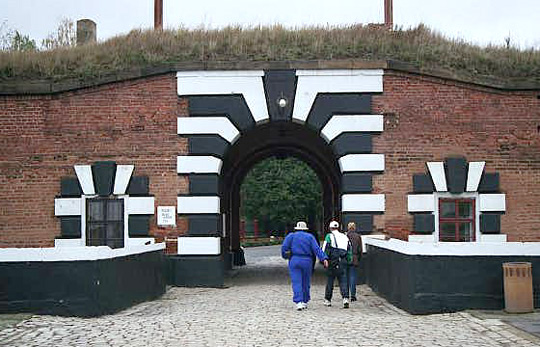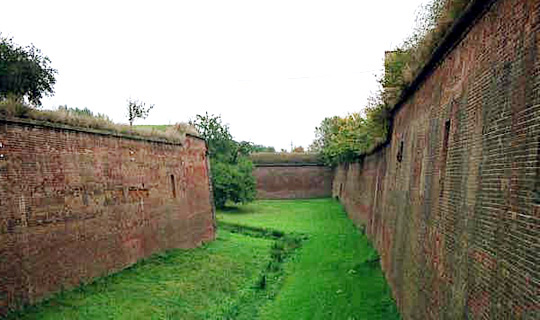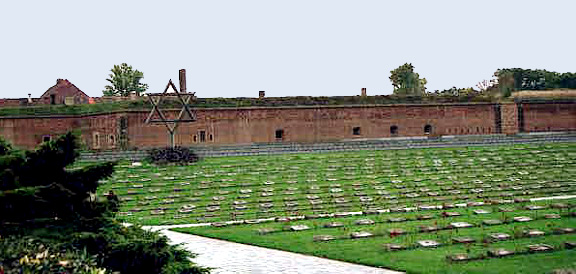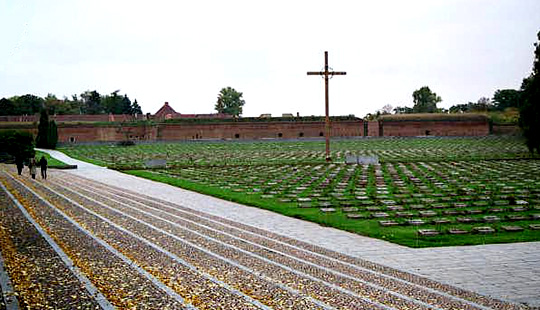Main Gate into
the Small Fortress

Tourists enter the
Small Fortress at Theresienstadt
I visited the Small Fortress at Theresienstadt
in the first week of October 2000 on a tour which I purchased
from one of the many tourist businesses in the city of Prague.
The tour was advertised as a five hour tour, but much of that
time was taken up by the drive to and from Theresienstadt, which
took about two hours, although the distance was only 60 kilometers
one way.
The road from Prague to Theresienstadt
is the main road which goes northwest to Dresden and then on
to Berlin; it has been in existence for centuries, but it is
still only a two lane road with opposing traffic for most of
the way.
For me, it was like traveling back in
time: the road to Theresienstadt is exactly the same as it was
in the days of the Third Reich and the railroad tracks which
brought the Jews to the ghetto are still there.
About two miles from Theresienstadt,
our bus passed through Bohusovice, the village where the Jews
had to get off the train and walk the rest of the way, lugging
their heavy suitcases, in the days before a branch railroad line
to the ghetto was constructed by the Jewish inmates.
The bus drove through beautiful farmland
with corn fields and many hop fields; in some places, the road
was lined with trees, displaying fall color. There were no farm
houses; the red-roofed houses were all grouped together in small
villages, just like in Germany. Beside the road, I saw one of
the "little chapels" which are typically seen in Poland.
These are wooden frames designed to display a statue of the Virgin
Mary near dangerous intersections, but the statue was missing
in this one.
There were signs on the road warning
drivers to look out for farm tractors, but I didn't see any during
our trip. As we approached Theresienstadt, I could see the distant
outline of the blue Sudeten mountains on three sides of us. Theresienstadt
is just over the border between the Sudetenland region and the
rest of the state of Bohemia.
Before we got to the Small Fortress,
the road went through the old walled town of Theresienstadt,
which is now called by the Czech name Terezin, but at that point
I didn't know yet that this was the old ghetto because, from
the road, it looks much like all the other small towns that we
had passed through. Suddenly I saw the zigzag brick walls of
the ramparts that surround the Small Fortress. The red brick
fortifications around the two fortresses are 4 kilometers long.
There are double walls around the fortress with a moat in between
them, as shown in the photograph below.
 Double walls around
the Small Fortress with a moat in between them
Double walls around
the Small Fortress with a moat in between them
When the bus stopped at the Small Fortress,
I was startled to see a cemetery in front of it with a large
Christian cross in the middle and a much smaller Star of David
behind it, placed closer to the entrance gate. I soon learned
that this was not an insult to the Jews, but a representation
of the truth since, contrary to what I had read in several tourist
guidebooks, very few Jews had died in the Small Fortress, according
to our guide.
I learned that the Small Fortress was
used by the Nazis, beginning in 1940, as a Gestapo prison for
Communists, anti-Fascist resistance fighters, partisans and guerrilla
fighters who were captured during in the war. There were 27,000
men and 5,000 women sent to the Small Fortress for "interrogation."
According to our guide, there were approximately 1,500 Jews sent
to the Small Fortress for fighting with the resistance movement
or for breaking the rules of the Theresienstadt ghetto. The guide
told us that 90% of the inmates in the Small Fortress during
the war were non-Jewish Czech Communists.
 Jewish star of David
in cemetery in front of brick wall around the Small Fortress
Jewish star of David
in cemetery in front of brick wall around the Small Fortress

Christian cemetery
at Small Fortress has cross with a crown of thorns
According to a pamphlet that our tour
group was given when we entered, there were 10,000 corpses buried
here between 1945 and 1958 after the bodies were exhumed from
mass graves at the Small Fortress, the Theresienstadt ghetto
and the nearby Litomerice concentration camp. There are 2,386
individual graves in the cemetery in front of the Small Fortress.
On September 16, 1945, a National Funeral was held here so that
the families could mourn their dead.
There were approximately 32,000 prisoners
who passed through the Small Fortress during the time that it
was a Gestapo prison from June 1940 until May 8, 1945 and between
2,500 and 2,600 of them died, including between 250 and 300 who
were executed, according to the pamphlet. There is another Jewish
cemetery at the location of the Crematorium building near the
Theresienstadt ghetto. However, our guide told us that most of
the prisoners at the Small Fortress were Communist resistance
fighters who were fighting against the Nazi Fascists.
Before we got to Theresienstadt, our
tour bus went through the ancient town of Litomerice where I
saw a spectacular white Baroque Christian church. Near an old
and very elaborate gateway on the road through the town, I caught
a glimpse of some old concrete posts of the type used for the
barbed wire fences around the concentration camps. I learned
that in the spring of 1944, a sub camp of the Flossenbürg
concentration camp was set up in Litomerice.
Around 18,000 prisoners were brought
to this sub-camp and given the job of building an underground
factory, which was code named "Richard." A large kommando
(work group) from the Small Fortress was sent to this underground
factory every day to work. The Nazis had started building all
their munitions factories underground because every city in Germany
was being bombed by the Allies. Working conditions at the "Richard"
factory were horrible and when the typhus epidemic in the eastern
concentration camps spread to the Litomerice camp, it resulted
in the deaths of 4,500 prisoners in less than a year, including
some of those from the Small Fortress.
After the arrival of the Soviet Army
on May 8, 1945, the prisoners at both the Small Fortress and
the Theresienstadt ghetto had to be held under quarantine until
the typhus epidemic could be brought under control. In just the
two months of April and May, 1945 there were approximately 1,000
deaths from typhus in the Small Fortress.
The pamphlet that we were given at the
entrance has a map of the fortress
on which all the places of interest are numbered for easy reference.
The entrance shown at the top of this page is number 1 on the
map and the graveyard is number 34, the last thing that visitors
see as they walk toward their tour bus in the parking lot.
|